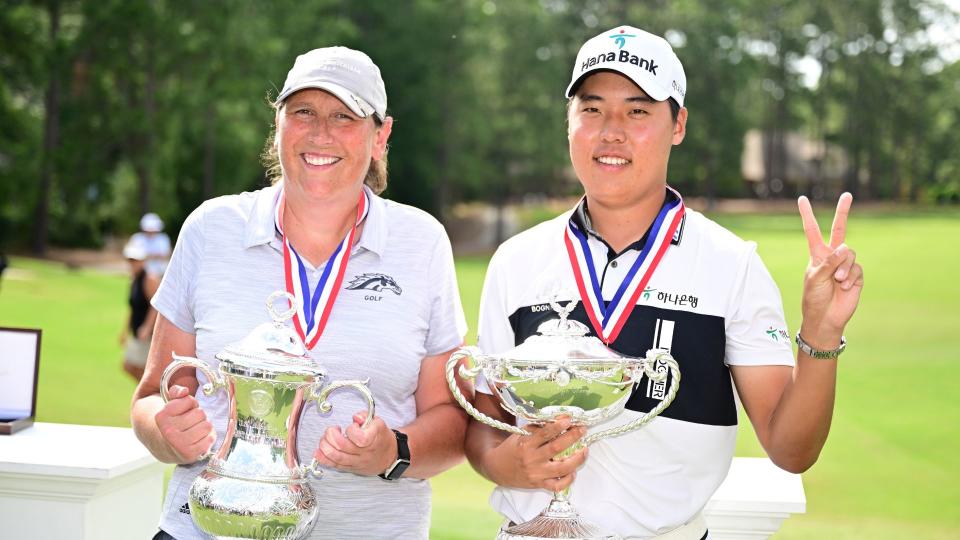What you need to know about the second edition of the U.S. Adaptive Open

Last year, the USGA staged the inaugural U.S. Adaptive Open at Pinehurst No. 6, showcasing and celebrating the world's best golfers with disabilities.
Safe to say it was a success.
"We all should be inspired watching the #USAdaptiveOpen," Tiger Woods wrote on Twitter. "Good luck to all the competitors and never give up!"
Now, a year later, the championship will head back to No. 6 on July 10-12, before heading to Sand Creek Station in Newton, Kansas, for 2024.
Here's what you need to know for the second playing of the U.S. Adaptive Open — the 15th USGA national championship:
The championship — open to any professional or amateur golfer with a handicap index not exceeding 36.4 who has an eligible impairment confirmed by a WR4GD Pass — will boast 96 players. A player’s individual handicap index was the primary factor in determining the field. Sixty-six players are returning from last year.
The field consists of at least five male players and two female players in each impairment category. The categories are arm impairment, leg impairment, multiple limb amputee, vision impairment, intellectual impairment, neurological impairment, seated players and short stature.
The championship will consist of three rounds of stroke play, 18 holes per day. The course will be set up to five different yardages, to coincide with impairment categories. The blue will play the longest at approximately 6,460 yards and the yellow will be the shortest at about 3,862 yards.
The overall men's and women's champions from last year, Simon Lee and Kim Moore, are back to defend their titles.
Moore, 42, is the head women’s golf coach at Western Michigan University. The Michigan native was born without a right foot, a severely clubbed left foot and a slight case of spina bifida. However, she played collegiately at the University of Indianapolis and was ranked in the NCAA Division II top 10 as an individual and was all-conference in each of her four years at school.
"This (win) is right up there probably really close to the top if not the top," Moore said following her wire-to-wire U.S. Adaptive Open victory last year. "I've won some able-bodied events in my time, in college. Never won when I was playing professionally, but I've won some national amputee golf championships. But this being all-encompassing has been very rewarding, and I would say it's probably right up there to the top."
Lee, a 26-year-old Korean who was diagnosed with a form of autism, has competed in several events as a professional on the Korean PGA Tour.
The average age of the field is 38.1, ranging from ages 16 to 77.
Bruce Hooper, who is visually impaired, is the oldest male competitor and Linda Port, 75, who is also visually impaired, is the eldest female player in the field.
The youngest competitors in the field are 16-year-olds Russell Aide and Sophia Howard, who was born without a right hand and took up the game at age 12. Recent high-school graduate, Luke Carroll, 17, is another teenager teeing it up this week. At 10 years old, Carroll was diagnosed with transverse myelitis, a neurological disorder of the spinal cord. His great-grandfather, George Stinchcomb, was a golf instructor with Cleveland Metro Parks and shagged balls for Ben Hogan.
The winners will earn an exemption into future U.S. Adaptive Opens (five years for the overall champion, one year for each impairment category champion). Plus, their names will be inscribed on a plaque recognizing all 2023 USGA champions that will reside in the Hall of Champions at the USGA Golf Museum and they will receive a gold medal and custody of the U.S. Adaptive Open Trophy for one year.
But no matter who comes out on top this year, every player in the field will serve as an inspiration — and that's what makes this championship so special.
"You just feel it out here. You feel the spirit and the excitement and the joy and people," Jordan Thomas, a multiple limb amputee, said at last year's event. "This is what is right with golf is exactly this championship. It’s a really privilege for me, and it’s an honor. ... I talk to a lot of people on the heels of tragedy, and a lot of people think that if they’ve lost a limb that their life is over. Here’s proof that life isn’t over, and this is living, tangible proof of that. For the USGA to say, hey, adaptive golf is going to become a national championship for us, I think it will propel the game forward in a huge way."
How to watch
Golf Channel will expand coverage of the second U.S. Adaptive Open to include live reports from Andy Stevenson, near real-time highlight packages, player features produced by Golf Channel Films, and player interviews during Golf Today (1 to 3 p.m. ET) and Golf Central (5 to 6 p.m. ET) on Golf Channel from July 10-12. The final 30 minutes of Wednesday’s Golf Central will be dedicated to covering the U.S. Adaptive Open with live coverage of the trophy ceremony.

